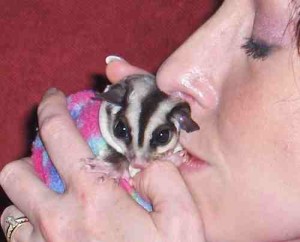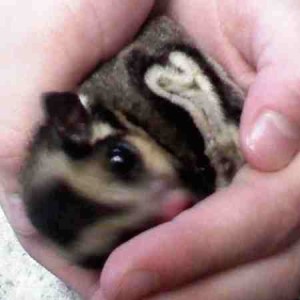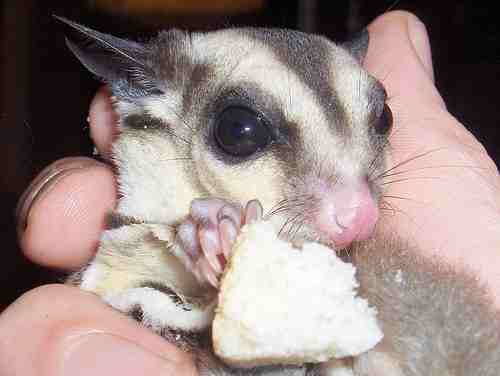 There are several things to consider while picking out your Sugar Glider. It is very important to take these considerations to heart so that you end up getting the best pet for your money. If you end up with the right Glider, you will absolutely love your new pet. You will also be glad that you took these steps in picking out your Sugar Glider because a little effort at this point will pay off for up to 15 years.
There are several things to consider while picking out your Sugar Glider. It is very important to take these considerations to heart so that you end up getting the best pet for your money. If you end up with the right Glider, you will absolutely love your new pet. You will also be glad that you took these steps in picking out your Sugar Glider because a little effort at this point will pay off for up to 15 years.
The first thing to consider is the breeder. You should always buy from a USDA licensed breeder with a good reputation for having quality animals. USDA breeders are inspected regularly by the agencies field representatives. Our breeding facilities must meet their standards for cleanliness, space temperature, space ventilation, feeding program, veterinarian program, and general care of the animals. In addition, we can be inspected at any time, any place, such as the shows that Tropical Attitude Pets attends. A good breeder does everything he does with the wellbeing of the animals in mind, at all times.
Ask to see the breeder’s license. If he has one, he should be glad to show it to you. Look to see if it is still in effect, and not expired.
It is always important to only buy animals that are 7 weeks to 12 weeks old. We find that this is the perfect age for bonding. Most animals older than the 12 week age will be set in its ways and will be much harder with which to bond.
It is also nice to have a large selection of animals from which to choose. At the trade shows, fairs, and festivals that we at Tropical Attitude Pets attend, we normally have 30 to 40 babies of the correct age from which to choose. At those shows we help you find just the right glider for you. The way we do that is by letting you hold several of the babies until you find the one or two that melt in your hands (or melt your heart). Just as important, we teach you how to hold the babies for the quickest bonding possible (more on this below). When you hold a baby for the first time remember that the baby does not know your scent and is on alert at least at first. There is a way to hold them so that they are feeling comfortable with you very quickly. If you don’t hold it that way it can take a long time for a glider to begin trusting you. We teach this to you first-hand at the shows.
Even more important than having a large selection is having a selection of quality animals. Our babies are hand raised. This means that the mom & dad raise the babies and feed them. However, we take the babies away from mom & dad daily for a short period of time and hold them in our hands. Sometimes they are placed in a pouch or pocket for a longer time. This daily handling causes the baby to have very little fear of humans in general by the time we take them to a show. All they need is to have a little time in a new persons hand in order to start feeling safe with them. We start handling them from the day their eyes open (about 10 days out of the pouch), and take them away from the parents around the 7th week out of the pouch. By the time we take them to a show for sale, they have been handled for at least 5 ½ weeks. As a result we have a great reputation for very sweet babies that will bond quickly if our methods are implemented. see Bonding with Your Sugar Glider!
Normally when we put a baby in your hands at a show it will be one we have selected for you to consider. It may be pulled from the cage, but more than likely it will be pulled from one of our shirt pockets. The reason for this is that the ones in our pockets are more acclimated to the environment of the show. I normally have Blanco in my tee shirt pocket, and in the two outer shirt pockets I will have about 3-4 baby girls in one, and 3-4 baby boys in the other. These babies have been in the pocket and have been shown off regularly that day. They not only get more used to being with me and being shown off, but they are getting more and more comfortable with being put in a new hand. When my potential customers hold those babies correctly the animal will normally fall asleep in their hands in 5-10 minutes. I call this having a good experience with an unknown person. Every time a Sugar Glider has a good experience with one person, it makes it easier to have a good experience with the next person. A Sugar Glider that has been held off and on throughout several hours and placed back in a pocket with a couple of other gliders in between, is normally a glider that will bond very quickly to the new owner that picks it. As these gliders are sold I replace them with other babies to help them become just as acclimated as the ones that have been sold.
So now you have a hand raised, 7-12 week old baby Sugar Glider in your hands for the first time. As mentioned above, it is very important to hold it correctly in order to get the maximum trust from the glider in the shortest time. When done well, it is not uncommon for the animal to be asleep in your hand within 5-10 minutes. Here is how to do it correctly: A glider needs to be given maximum security and isolation at first. We are going to do this with one hand only. The second hand can be placed over the first after you are holding it properly in the first hand. This will give even more isolation to the baby. So the way to hold them is to place the glider on its back in the palm of one of your hands with its head up towards the thumb. Then wrap your fingers around the glider and use your thumb to tuck its head into its belly. The tail will usually be hanging out, so take the tail and wrap it up into your hand along the body of the baby. You now have your baby in one hand curled up like a little ball about the size of a walnut. Now what you need to do is squeeze. It is hard to get a person to squeeze a baby tight enough to make it feel safe, but when you do, you will know you are doing it right because the baby will just relax in your hand and stop making any of its scared noise called crabbing.
The reason this method works so well is that by doing the above you are giving the baby the same sense of security and isolation that it felt when it was in Mom’s pouch. In there it was very tight, warm, and isolated from all of the scary things that are out there in the world. 
If you will then continue to hold the baby that way for an extended period of time you may feel the baby start to relax (the pounding heartbeat slows to where you can hardly feel it), and as the heartbeat goes away, it may start vibrating almost like a motor is running in its belly. This is really a purr and is actually the second level of trust. (The first being the slow heartbeat) Next if you continue to hold it this way, it will stop purring. At this time it is probably sleeping in your hand. This is the third level of trust. Once you have reached this stage and the animal is asleep, it is imprinting on its brain that you and your scent is a safe place to be.
If you buy that one, it will no doubt bond well with you. If you don’t buy that one, it will be just that much easier for it to trust the next Person.
The difficult thing about this method is that you need to hold that baby for 5-10 minutes at least and you are not seeing it at all. Of course everyone wants to see them and often open their hands too soon and it may scare the glider. Just tighten your hold and cover it up again. If you look at it eye to eye too soon it can scare the glider before it has time to trust you. After it has gone to sleep, then you can release the pressure somewhat and often it will continue to sleep and you can admire it.
After a while of doing this (which may be more than just at the show), your glider will not be afraid while you hold it in an open hand sleeping or even while he grooms himself.
A couple of other mistakes people often make at first is putting it up to your face, and or trying to kiss it. This scares a glider that does not know you. For all he knows you are planning on eating him.
Some gliders also are afraid of direct eye contact at first. This may remind them of the instinct to avoid their main predators, birds. To a new baby glider your staring eyes could be a hawk or an owl ready to attack. If this is a problem, just glance at the glider askance rather than directly.
Another common mistake is making clucking noises at it, or shushing noises. This can work well with some other animals but not with a scared baby Sugar Glider. The reason is that these noises sound too much like their scared noise, the crabbing. The crabbing can make them feel as if there is another glider warning him that there is something harmful near. Instead, just talk to the glider in soothing tones and let him get used to your voice.
This subject was to discuss picking out a glider. To learn more about bonding, go to the faq
 There are several things to consider while picking out your Sugar Glider. It is very important to take these considerations to heart so that you end up getting the best pet for your money. If you end up with the right Glider, you will absolutely love your new pet. You will also be glad that you took these steps in picking out your Sugar Glider because a little effort at this point will pay off for up to 15 years.
There are several things to consider while picking out your Sugar Glider. It is very important to take these considerations to heart so that you end up getting the best pet for your money. If you end up with the right Glider, you will absolutely love your new pet. You will also be glad that you took these steps in picking out your Sugar Glider because a little effort at this point will pay off for up to 15 years.

